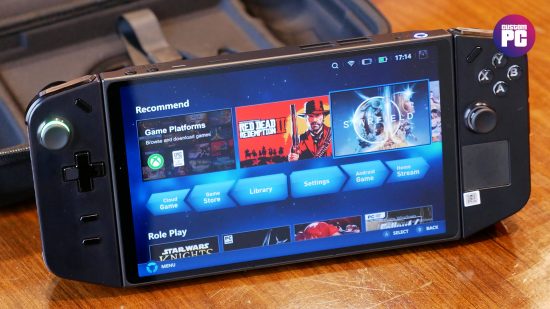Of all the recent gaming handhelds – even the original Steam Deck – the Lenovo Legion Go has in some ways excited us the most. The Steam Deck and Asus ROG Ally‘s more compact size makes them more portable, but their limited 7-inch screen size and fixed side controls make them devices that resolutely are designed for a single purpose. However, the Legion Go’s larger 8.8-inch screen and detachable controls make it a far more versatile device, at least in theory. We got to see how that theory holds up with our recent opportunity for a Lenovo Legion Go hands on preview.
Lenovo Legion Go design
Put simply, the Legion Go is a bit of a monster. While the ROG Ally and Steam Deck are far from pocketable devices, the extra few millimeters of width and height of the Go are noticeable. Plus, the tablet section while not much thicker than its competitors, feels more noticeably chunky because once you detach the controllers, it becomes the thickest ~9-inch tablet known to man.
The fact the tablet section is also dotted with large ventilation holes with very visible cooling fins and a blower fan also puts it far away from the sub-1cm Android tablets or iPads of this world.

That said, the main reason the tablet section isn’t something we’d necessarily want to use as a daily tablet driver – other than Windows being a poor tablet interface and battery life being mediocre – is that it doesn’t have a dedicated tablet case. It has a built-in kickstand for setting on a flat surface but there’s no grippy leather case back for propping it on your lap or flip-round protective cover for the screen. It’s simply not a device you’d want to chuck around in the same way.
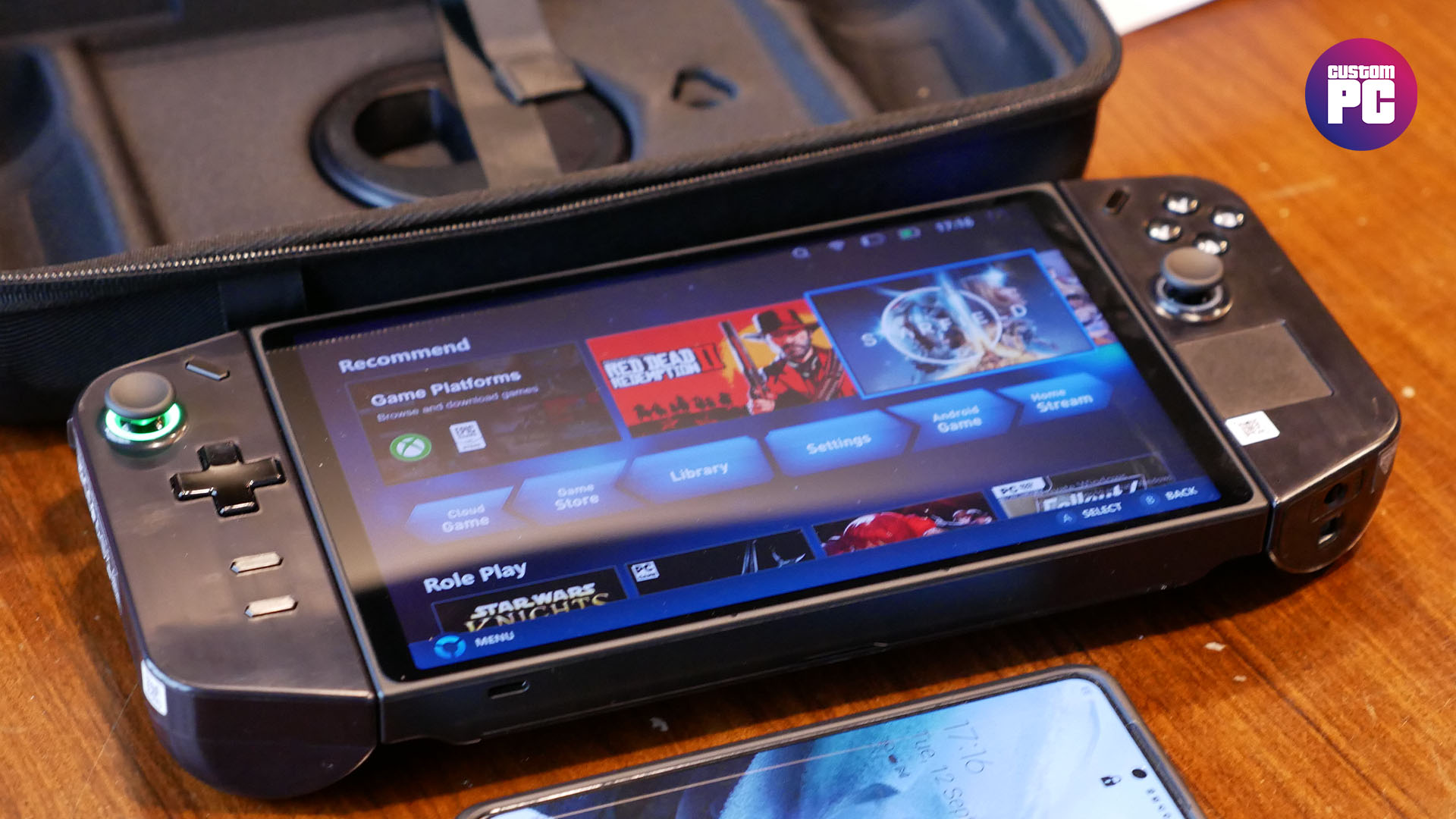
Still, considering you’re getting a screen that’s nearly two inches wider than its direct competition yet you have the option to slim the device down to just a tablet, the versatility is technically there, and we’re all for it.
As for styling, the above thoughts also apply, in so much as this feels like quite a utilitarian device. The back is metal – as is the adjustable-angle fold-out kickstand – and the whole thing feels well made, with quality plastics used throughout, but the look is very much function over form. The only relief from the plain black coloring and simple forms are the rings of RGB lighting around the thumbsticks. You can adjust the brightness and color of these rings (including turning them off) in Lenovo’s included Lenovo Space software.
One thing we are happy to see is that repairability seems decent, with the back plate held on with normal crosshead screws, making it easy to get to the cooling hardware, blow out dust and other detritus, or potentially perform some upgrades.
The device also ships with a large semi-rigid, form-fitting, zip-up case that also houses the mouse converter holder and has cutouts for charging the device while in the case.
Lenovo Legion Go controls
The Legion Go’s biggest trump card, other than its large screen, is its detachable controls. Like the Nintendo Switch, the controls unclip from the sides of the device and offer wireless operation so that you can place the tablet section on a desk, coffee table, seat-back table, train table, or wherever else you like.
It’s an extra freedom of movement that’s surprisingly welcome, even when you’re not placing the screen much further than an arm’s length away. Sometimes, it’s just a more comfortable angle to use in this way, or you may want to play two-person games. Plus, it means you don’t have to take the weight of the biggest, heaviest part of the system. It’s also beneficial for cooling, compared to being laid on a lap or flat against your knees in bed.
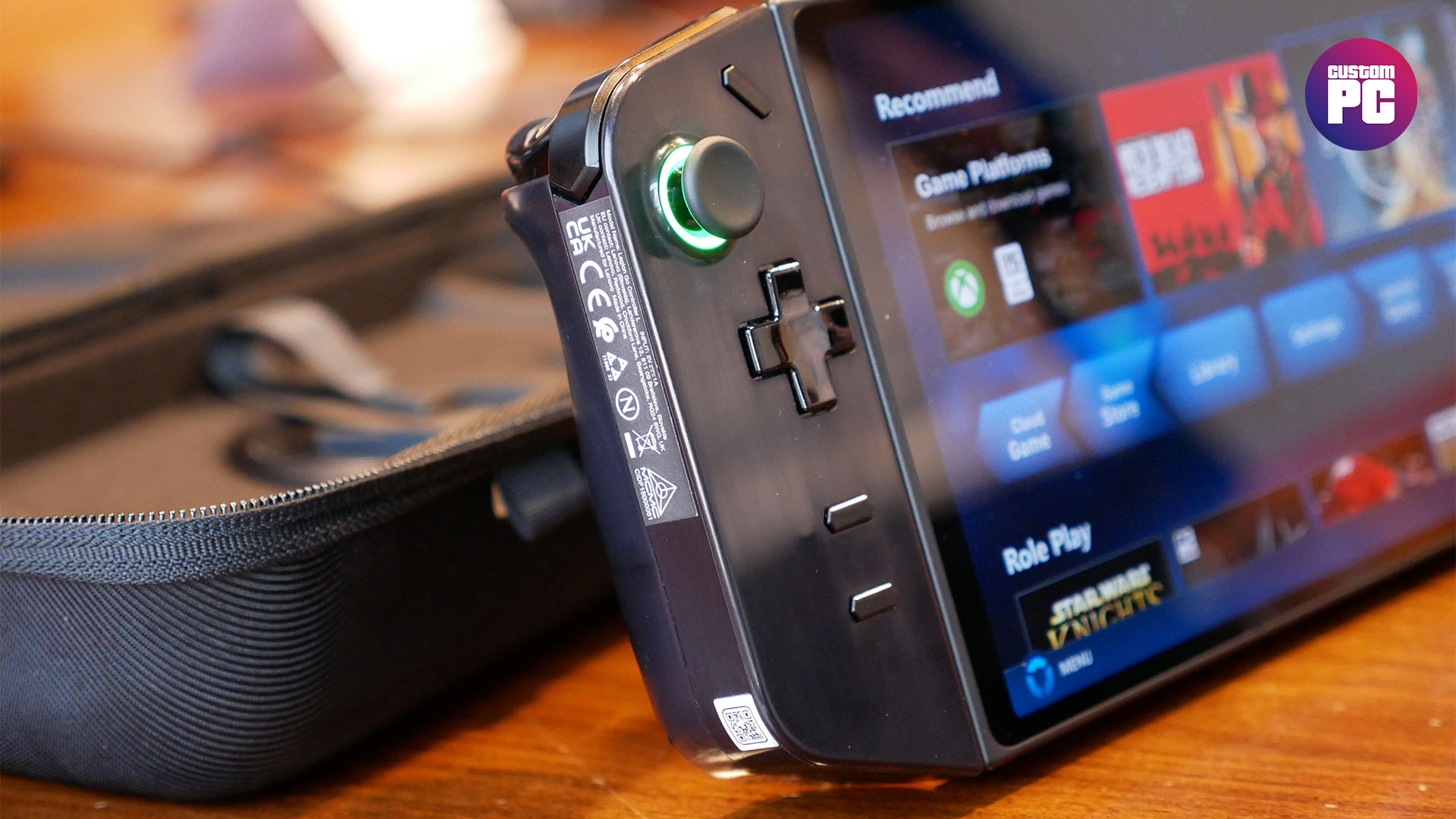
The controls unclip by pressing a button on the back and then sliding them down slightly. It takes a little getting used to, but the mechanism feels robust and is far quicker and easier than the Nintendo Switch Joy-Cons.
Once attached, small gold contacts connect and charge the controllers, but there’s no way of charging separately or swapping out the batteries, without dismantling the whole controller. We can understand the logic behind keeping everything contained, but getting caught with a dead controller while using the controllers in detached mode would be frustrating. Plus, that makes for three rechargeable batteries that will eventually need replacing, not just the one main battery as on all-in-one devices.
The selection of buttons, thumbsticks, and other controls is comprehensive. On the left controller is a thumbstick, a D-pad, three small menu buttons, a side bumper button, an analog trigger, and two rear buttons. Meanwhile, the right controller also houses a thumbstick, ABXY buttons, a small trackpad, two side bumpers, an analog trigger, and a single rear button and a scroll wheel.
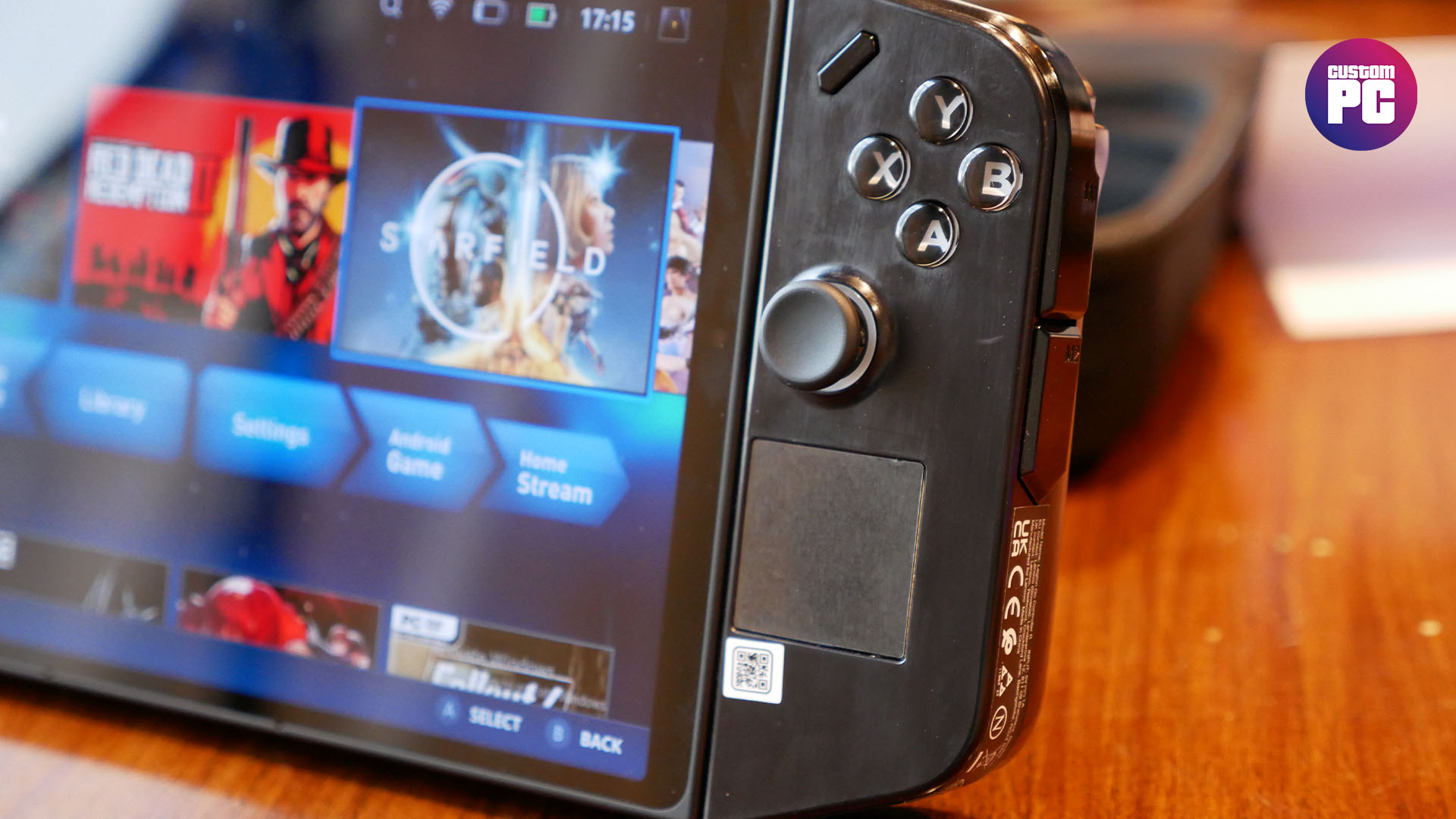
All the controls fell into fairly natural-feeling positions for me, with my 20cm long hands (from wrist to middle fingertip) only feeling slightly cramped trying to reach the rear buttons. The overall size of the device may put off some users anyway, but otherwise the controls feel like they’re well-balanced for different hand sizes.
The quality of the controls felt decent too, though sadly the right-side controller on the test sample we used wasn’t working. As such we couldn’t test the trackpad and were limited in what game tests we could do. Nonetheless, the left controller’s thumbstick felt smooth and accurate while the other buttons had just the sort of feel you’d expect from a quality game controller. The thumbsticks also use Hall effect sensors, so stick drift shouldn’t be an issue, plus they have removable caps. Each controller also offers gyro control – like VR headset controllers – but again we weren’t able to test this feature.
Another feature that we didn’t get to try is that the right controller can also double as a mouse. Flick a switch on its underside and mount the unit in a provided holder and you can slide it around like a vertical mouse – a bit like the Posturite Penguin. It felt a bit of a stretch to suggest this is an FPS mode, as Lenovo has done, though, as we generally find these vertical-style mice aren’t conducive to easy, precise movements. It’s still a neat trick though.
Away from game controls, you also get power and volume buttons on the top edge of the tablet, with the former being illuminated with the Legion three-part ‘O’ logo.
Lenovo Legion Go screen
The biggest draw of the Legion Go for many will be its much larger screen than the Asus ROG Ally and Steam Deck. At 8.8 inches from corner to corner, it’s nearly two inches larger than its two main rivals, and you really do notice the extra size.
We’ve popped the Legion Go next to a Samsung S21 mobile phone for a screen comparison size in our pictures. That phone has a 6.2-inch screen and even though 7 inches is obviously bigger still than this phone, you can get a sense of how significant a step up you’re getting.
Fire up a video or game on the Legion Go and it feels every bit the contender to a proper Android tablet or iPad. Likewise, you can just about actually do stuff on the Windows 11 desktop. Meanwhile, the 7-inch screens of the Asus ROG Ally and Steam Deck feel like far less of an upgrade in viewing pleasure from just a typical-size smartphone.
You absolutely pay the price in terms of weight and overall device dimensions for the large screen but thanks to the detachable controllers, the Legion Go tablet section can be a much smaller device than its rivals, if you just want a larger portable screen.
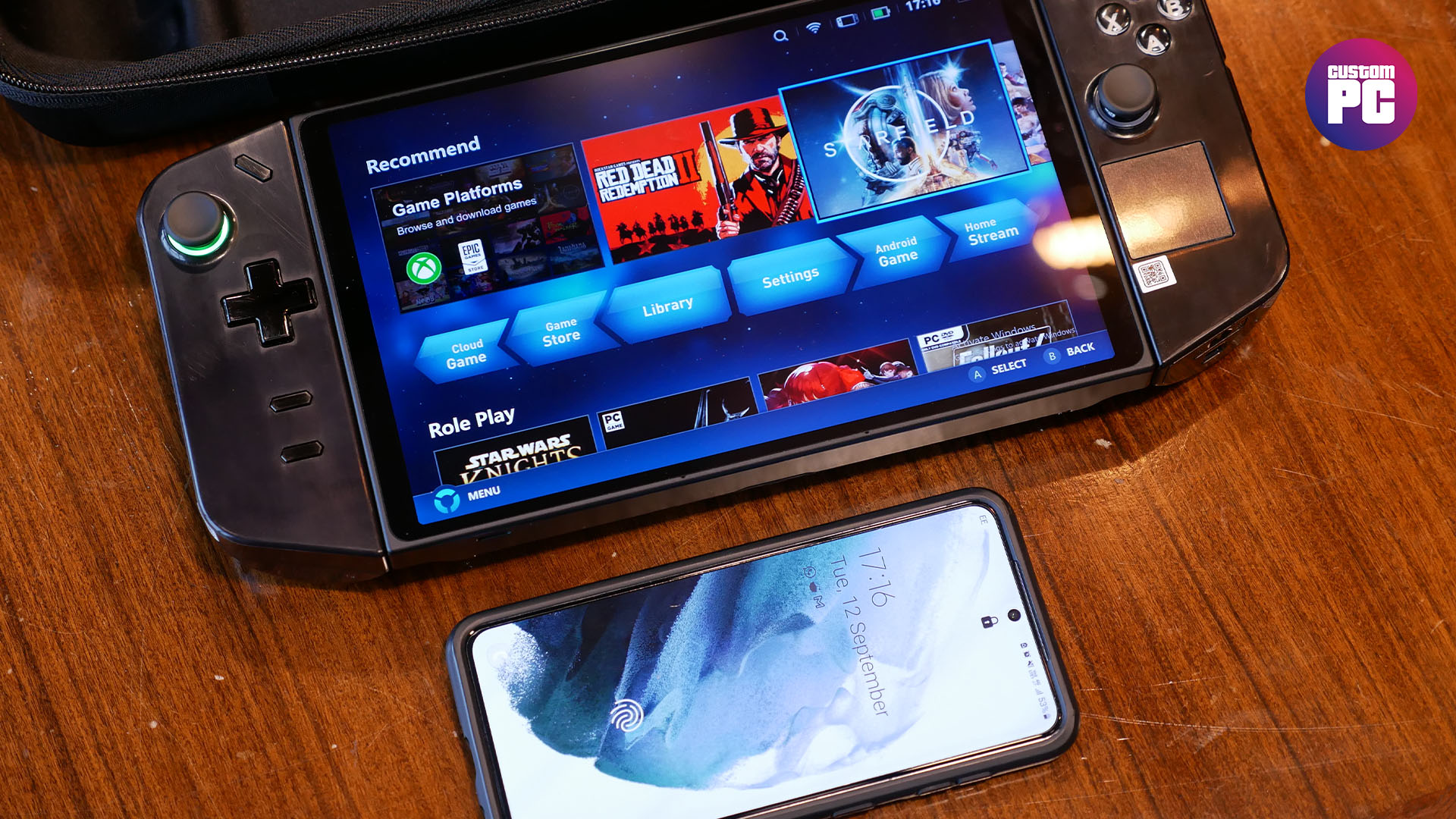
Another key aspect of this screen is its taller aspect ratio than the Asus ROG Ally. While that tablet has a 16:9 screen, the Legion Go, like the Steam Deck is 16:10. On such a small screen, that extra screen height is particularly welcome for using the desktop, though is actually less useful for gaming and video.
When it comes to the higher 2,560 x 1,600 resolution of this screen, compared to the 1,920 x 1,080 and 1,280 x 800 resolutions of the Ally and Steam Deck, the benefit isn’t immediately obvious in many instances. It feels like Lenovo could easily have used a 1,920 x 1,200 screen and not made any meaningful difference to the sharpness and usability of the panel. Nonetheless, the pixels are there if you need them – sometimes you just have to browse a complex spreadsheet on the move.
It’s also worth remembering you can run the screen at a lower resolution, with or without upscaling. Lenovo’s software provides quick access to converting the tablet to run at a Steam Deck-matching resolution of 1,280 x 800 or 1,920 x 1,200, saving you from having to mess around too much with Windows settings.
When it comes to the 144Hz refresh rate of this panel, the step up from the 120Hz of the ROG Ally is all but imperceptible and unlikely to be of any benefit for the type of gaming most users will do on a device like this. However, the step up from the 60Hz of the Steam Deck is transformative for both gaming and general use, with scrolling and other interactions feeling incredibly smooth.
All this and the quality of the nanoIPS miniLED panel is excellent. Colors are punchy with seemingly excellent contrast – it was difficult to fully test in our sunlit test room – and the panel can cover up to 98 percent of the DCI-P3 color space too, for HDR-like color vividness. The display is rated to DisplayHDR 600 standards too.
Lenovo Legion Go ports and IO
As an x86_64 Windows 11 device, the Legion Go can in theory support all the devices you’d expect of a Windows machine, and to that end, you get a couple of USB 4 and Thunderbolt 3-certified USB-C ports for charging, video output, and connecting other devices. The USB-C ports will support external GPUs and you can connect directly to monitors too, as well as plug in your favorite gaming mouse, gaming headset, or gaming keyboard.
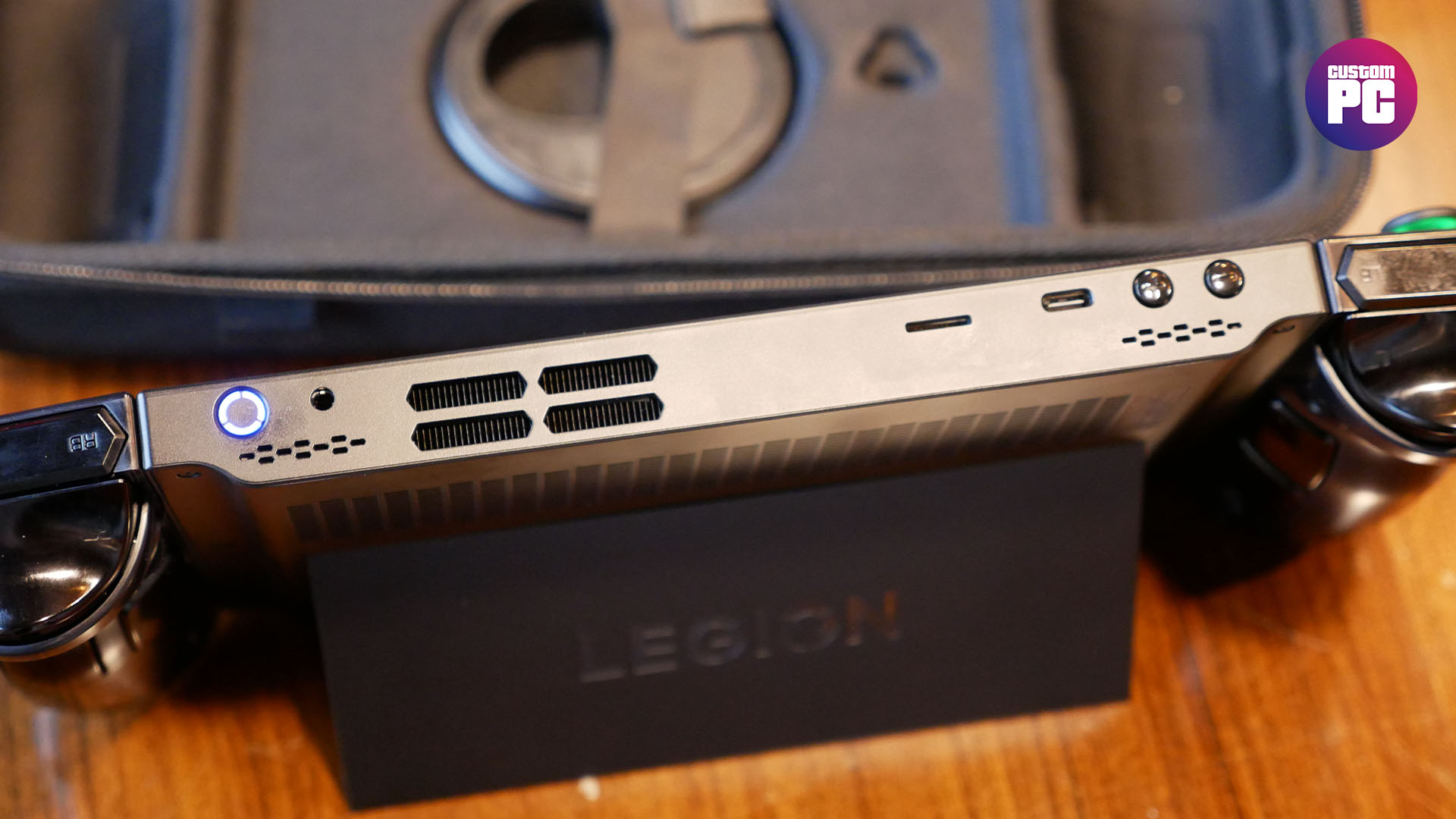
You also get a standard headphone jack along with a microSD slot that can expand the device’s storage by up to 2TB. Bluetooth and WiFi are of course onboard too. All told, if only we’d had a keyboard, mouse or controller at the press event, we might have actually been able to get around the broken right controller issue – thanks, RockPaperShotgun, for breaking it!
Lenovo Legion Go gaming performance
As mentioned above, problems with the right controller meant that we were limited in how we could interact with games on the Legion Go test sample. Even more of a problem, though, was that Lenovo had only loaded Rocket League onto the device to test, and they weren’t giving permission to film or photograph the game.
However, we did what we could to get a sense of the device’s gaming capability. Running that game, we found the Go could crank out 66fps with the game running at the screen’s full resolution and with most in-game settings set to high. Yes, it’s not a demanding game, but that’s still a very reasonable result for a game running at 2,560 x 1,600.
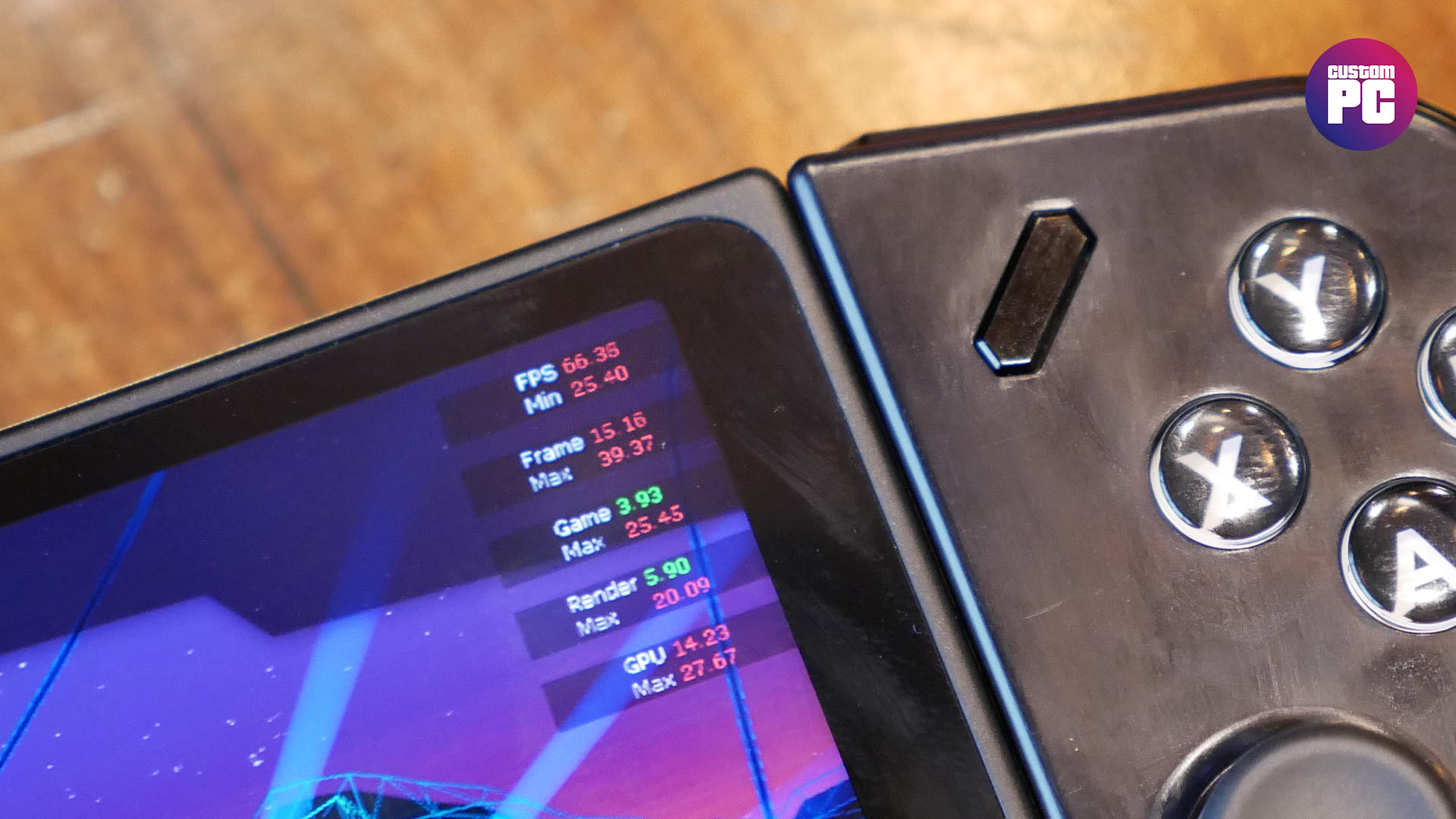
With the game running at 1,280 x 800 the device was maxing out its 144Hz refresh rate. Sadly, because of the lack of ability to control the cars in the game, we couldn’t really properly get a sense of the feel of that extra frame rate but the game’s in-game fps counter told us that’s what it was delivering.
Ultimately, if you run the Legion Go at 1,920 x 1,200, the performance of the handheld should be fairly in line with the ROG Ally, as both use the same AMD Z1 Extreme processor. The really big difference will be in whether there’s any meaningful benefit in gaming with the higher resolution screen. If all you’re getting is single-digit or low 20s fps numbers for running modern games at that resolution, it’s all a bit pointless. Technologies like FSR and FSR 3 frame generation can help bridge the performance gap but you need at least a 30fps+ baseline to get anywhere with those technologies.
Lenovo Legion Go cooling and noise
The Go employs a single main blower-type fan to suck in air from the back of the tablet and out through the top edge. It seemed fairly quiet for the amount of air it was pushing when under heavy load, but the room we were in was quite noisy so it was hard to tell. Certainly, there was no very obvious whine or rattle from the cooling system.
The device got warm to the touch in use but not alarmingly so – the active cooling system seemed to do a good job of ramping up when needed. As ever with this type of device, the real moments to look out for will be when the cooling system gets stifled by duvets, blankets, and other loose fabrics that you might be resting the device on.
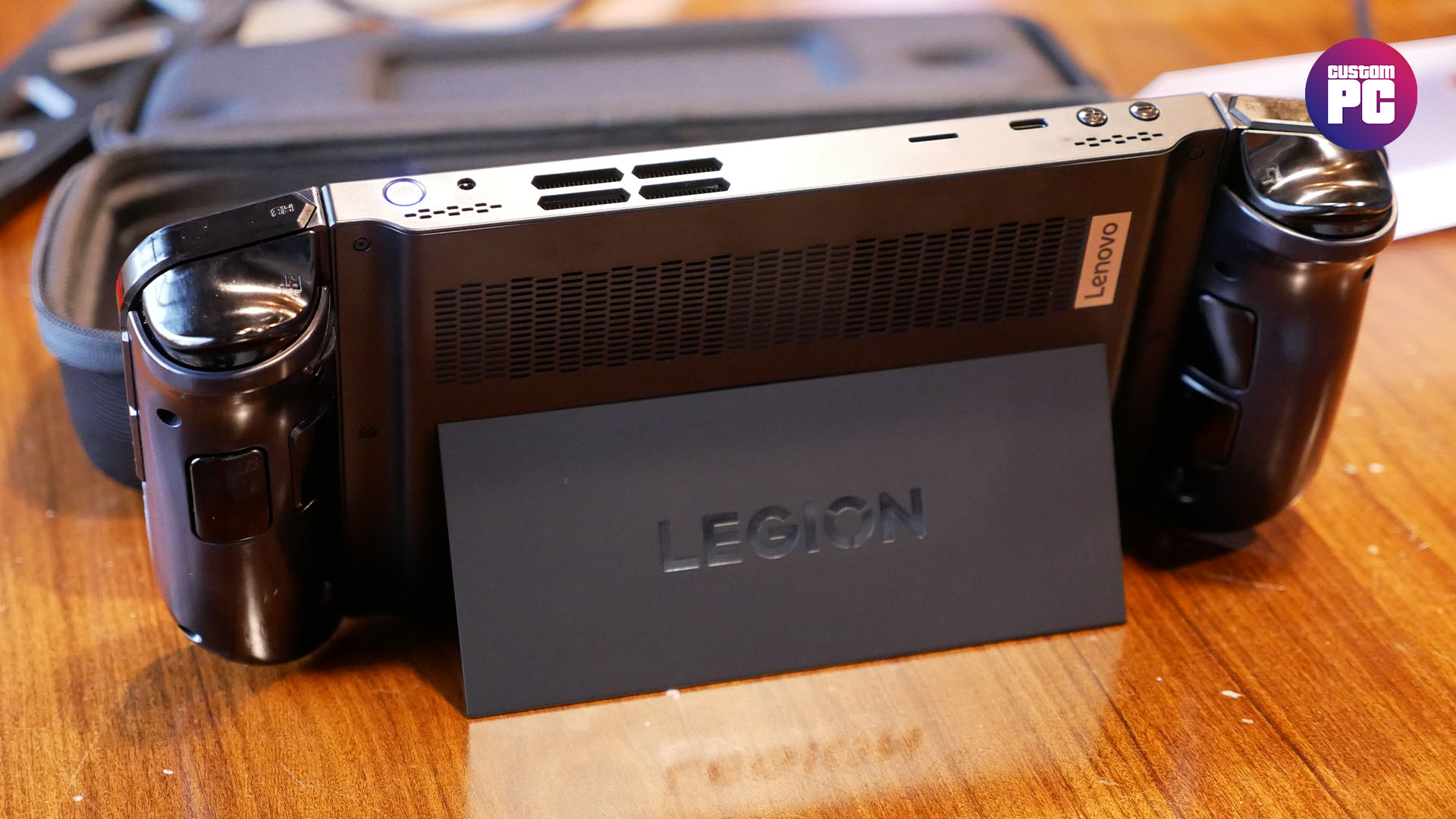
You can manually fine-tune the likelihood of the cooling system ramping up by setting the device to run at different thermal levels in Lenovo’s software. By default, the system can run at a peak 32W of power but you can also turn this down to 21W or even 8W modes. Alternatively, when plugged in you can run it at 42W for a boost in processing power.
Lenovo Legion Go battery life
We can’t really speak to the real-world battery life of the Legion Go yet, as our time with the device was just under an hour. However, in the time we were using it and having it demoed, it wasn’t charged once and used less than a quarter of its power.
In theory, its 49.2Whr battery might be able to outlast the 40Whr units of the Steam Deck and ROG Ally, but the larger, higher-resolution screen could just as easily swallow up the difference. Ultimately, you’re likely to get around two hours of use when gaming, and up to around eight hours for other uses.
Lenovo Space software
Lenovo has added a software layer to the Legion Go that provides a slick default interface for controlling the device. It provides access to settings such as brightness, Bluetooth, thumbstick RGB, WiFi, power modes, thermal modes, and much more. You can also add game stores to this interface, bringing your varied game libraries together in one place.
This software is impressively fluid, working incredibly smoothly with the fast refresh rate screen and being easy to navigate using the D-pads, thumbsticks, or touchscreen. It’s also easy to jump back to the Windows interface and you can set the device to load straight to Windows or Lenovo Space. Who knows how good ongoing support for the software will be from Lenovo, but at the very least Windows is there to still provide a functional device, even if Lenovo’s software starts to be more of an encumbrance than a benefit.
Lenovo Legion Go specs
The Lenovo Legion Go specs list is:
| Lenovo Legion Go | Asus ROG Ally | Steam Deck | |
| Architecture | AMD Zen 4 / RDNA 3 | AMD Zen 4 / RDNA 3 | AMD Zen 2 / RDNA 2 |
| CPU | AMD Z1 Extreme eight cores / 16 threads up to 5.1 GHz | AMD Z1 Extreme 8C/16T @ 5.1 GHz / AMD Z1 6C/12T 4.9GHz | AMD Van Gogh four cores / eight threads up to 3.5 GHz |
| GPU | AMD iGPU 12CU @ 2.7 GHz |
AMD iGPU 12CU @ 2.7 GHz 4CU @ 2.5 GHz |
RDNA2 8 CU @ 1.6 GHz |
| External GPU | Yes, via USB-C port | ROG XG Mobile (up to GeForce RTX 4090) | N/A |
| Memory | 16GB LPDDR5X | 16GB LPDDR5 | 16GB LPDDR5-5500 |
| Storage | 1TB / 512GB / 256GB | 512GB / 256GB | 64GB eMMC (1x PCIe 2) 256GB/512GB NVMe (4x PCIe 3) |
| Display | 8.8-inch 2,560 x 1,600 144Hz | 7-inch 1,920 x 1,080 120Hz | 7-inch 1,280 x 800 60Hz |
| Connectivity | Wi-Fi X, BT 5.2, 2 x USB-C (USB 4 / Thunderbolt 3), headphone | Wi-Fi AX, BT 5.2 | Wi-Fi AC, BT 5 |
| Battery | 49.2 Whr, 900 mAh (controllers) | 40 Whr, 4S1P, 4-cell Li-ion | 40 Whr |
| Weight | 854g | 608g | 669g |
| Dimensions | 29.9 x 13.1 x 4.1 cm | 28.0 x 11.3 x 3.9 cm | 29.8 x 11.7 x 4.9 cm |
| OS | Windows 11 | Windows 11 | Steam OS/Windows 11 |
| Price | $799 / €799 | $699 / €799 (Z1E+16G+512GB) $599 / €699 (Z1+16G+256GB) |
$399 (16G+64GB) $529 (16G+256GB) $649 (16G+512GB) |
Lenovo Legion Go release date
The Lenovo Legion Go release date is 31st October 2023.
Lenovo Legion Go price
The Lenovo Legion Go price is $799 / €799 / £699, making it $100 cheaper than the Asus ROG Ally in the US but the same price in Euros.
Lenovo Legion Go first impressions
We’re generally rather impressed by the Lenovo Legion Go. It may not be the slickest-looking piece of hardware and it’s a bit of a hefty unit but that hybrid ability to be a rather chunky but large-screened tablet as well as a high-quality gaming handheld is compelling.
Other handhelds just don’t deliver that same level of large-screen overall entertainment while regular tablets or phones aren’t anywhere near as accomplished for gaming. Perhaps, with longer use, we’ll realize that the 7-inch screen size of the Steam Deck is the right balance after all but upon initial impression, we’re fans of the larger, hybrid format.
What’s without doubt is the screen is great quality, as is the general build of the device, while its performance is impressive too. You may have to do plenty of fine-tuning to get playable performance in certain modern games, but that’s still only to be expected for what is ultimately a sub-900g handheld device.
What have your thoughts been so far on the Lenovo Legion Go? Has its detachable controller form factor excited you or does it just seem too unwieldy? Let us know your thoughts on the Custom PC Facebook page, via Twitter, or join our Custom PC and Gaming Setup Facebook group and tap into the knowledge of our 420,000+ members.
Meanwhile, you can also check out the full Steam Deck review and Asus ROG Ally review on our sister site PCGamesN, for a deeper dive into those devices.
